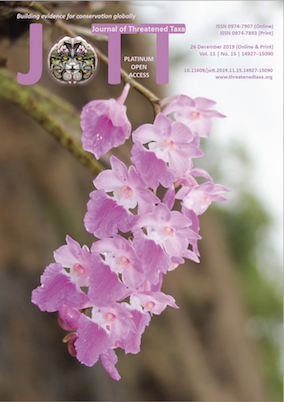A comparative analysis of hair morphology of wild and domestic ungulate prey species of Leopard Panthera pardus fusca (Mammalia: Carnivora: Felidae) from Goa, India
Main Article Content
Abstract
Guard hairs were collected from four live domesticated ungulate species and shed guard hairs of six wild ungulate species from zoo captive animals from five individuals each. Photographic reference was prepared showing analytic features of hair characteristics. Study results were analysed and cuticle and medulla patterns were identified along with pigmentation features from the literature available for wild and domestic ungulates from India and abroad. Clear and easily distinguishable morphological characters of hair medulla and cuticle were used in the present study. Scat analysis of big cats used in this study is easy, speedy and efficient which can be used in routine investigations related to wildlife, crime forensics as well as human animal conflicts by studying carnivore feeding habits. In a majority of the animal species, the distal part of the hair showed maximum variation from the rest of the hair portions. The cuticle scales were imbricate in all tested animals. Scale position in almost all the tested animals was transversal except in goat (proximal part and medial part) and mouse deer (Distal part). Majority of the species showed smooth margins at proximal and medial part. Whereas the distal part scale margin was crenate and rippled in appearance the proximal part and medial part of hair of the majority of sampled animals showed a regular wave -type scale pattern whereas the distal part of hair showed irregular wave-type scale pattern in dominance. The composition of the medulla was multicellular in all the sampled deer species. Only the cow calf’s hair medulla was unicellular and uniseriate in appearance. A comparison of the hair of the domestic pig with that of the wild boar and gaur hair with that of cow calf and buffalo calf hair was made for the first time in the present study. Similarly goat hair morphology can also be differentiated from other cervids in this study. Medulla and cuticle characters in combination with each other can help differentiate wild ungulate species from the domestic ones since these wild ungulate species are frequently involved in hunting crime investigations. Therefore, the photographic reference presented in this study can be used in wildlife forensic science as well as predator diet analysis as an appropriate reference for prey species identification.
Article Details
Authors own the copyright to the articles published in JoTT. This is indicated explicitly in each publication. The authors grant permission to the publisher Wildlife Information Liaison Development (WILD) Society to publish the article in the Journal of Threatened Taxa. The authors recognize WILD as the original publisher, and to sell hard copies of the Journal and article to any buyer. JoTT is registered under the Creative Commons Attribution 4.0 International License (CC BY), which allows authors to retain copyright ownership. Under this license the authors allow anyone to download, cite, use the data, modify, reprint, copy and distribute provided the authors and source of publication are credited through appropriate citations (e.g., Son et al. (2016). Bats (Mammalia: Chiroptera) of the southeastern Truong Son Mountains, Quang Ngai Province, Vietnam. Journal of Threatened Taxa 8(7): 8953–8969. https://doi.org/10.11609/jott.2785.8.7.8953-8969). Users of the data do not require specific permission from the authors or the publisher.
References
Athreya, V., M. Odden, J.D.C., Linnell, J. Krishnaswamy & K.U. Karanth (2014). A cat among the dogs: leopard Panthera pardus diet in a human-dominated landscape in western Maharashtra, India. Fauna & Flora International Oryx 50(1): 1–7. https://doi.org/10.1017/S0030605314000106
Brunner, H. & B.J. Coman (1974). The identification of mammalian hair. Oryx 13(4): 396–397. https://doi.org/10.1017/S0030605300014253
De Marinis, A.M. & A. Asprea (2006). Hair identification key of wild and domestic ungulates from southern Europe. Wildlife Biology 12(3): 305–320. https://doi.org/10.2981/0909-6396(2006)12[305:HIKOWA]2.0.CO;2
Debelica, A. & M.L. Thies (2009). Atlas and key to the hair of terrestrial Texas mammals. Museum of Texas Tech University, Lubbock, TX (Museum of Texas Tech University, Special Publications, No. 55).
Deedrick, D.W. & S.L. Koch (2004a). Microscopy of Hair Part II: A practical guide and manual for animal hairs. Forensic Science Communication 6(3): 1–32.
Dharaiya, N. & V.C. Soni (2012). Identification of hairs of some mammalian prey of large cats in Gir protected area, India. Journal of Threatened Taxa 4(9): 2928–2932. https://doi.org/10.11609/JoTT.o3032.2928-32
ENFSI (2015). Best practice manual for the microscopic examination and comparison of human and animal hair. ENFSI-BPM-THG-03, ver. 01. European Network of Forensic Sciences Institutes, 63pp.
Ghallab, A., Y.A. Ahmed, & S. Ali (2018). Hair histology as a tool for forensic identification of some domestic animal species. EXCLI Journal 17: 663–670.
Harkey, M.R. (1993). Anatomy and physiology of hair. Forensic Sci International 63(1–3): 9–18.
Knecht, L. (2012). The use of hair morphology in the identification of mammals, pp. 129–143. In: Huffman, J.E. & J.R. Wallace (eds.). Wildlife Forensics: Methods and Applications. Wiley-Blackwell, 396pp.
Krumbiegel, F., M. Hastedt, S. Eichberg, N. Correns, R. Gapert & S. Hartwig (2014). Hair analysis in the detection of long-term use of non-steroidal anti-inflammatory drugs and its relation to gastrointestinal hemorrhage: an examination of 268 hair and blood samples from autopsy cases. Forensic Science, Medicine and Pathology 10(1): 18–28.
Menike, U., D. Manawadu & S. Meegaskumbura (2012). Identification of Sri Lankan shrews using hair anatomy. Ceylon Journal of Science 41: 45–66.
Mukherjee, S., S.P. Goyal & R. Chellam (1994b). Standardisation of scat analysis techniques for Leopard (Panthera pardus) in Gir National Park, Western India. Mammalia 58: 139–143.
Ramakrishnan, U., R. G. Coss & N.W. Pelkey (1999). Tiger decline caused by the reduction of large ungulate prey: evidence from a study of leopard diets in southern India. Biological Conservation 89: 113–120.
Soni, V.C., R. Kushwaha & N. Dharaiya (2003). Structural variations in the hair from different body parts of the Indian Ratel (Mellivora capensis). Journal of Tissue Research 3(1): 60–63.
Teerink, B.J. (1991). Hair of West-European Mammals Atlas and Identification Key. Cambridge University Press, Cambridge, 223pp.
Tridico, S. (2005). Examination, analysis, and application of hair in forensic science - animal hair. Forensic Science Review 17(1): 17–28.

